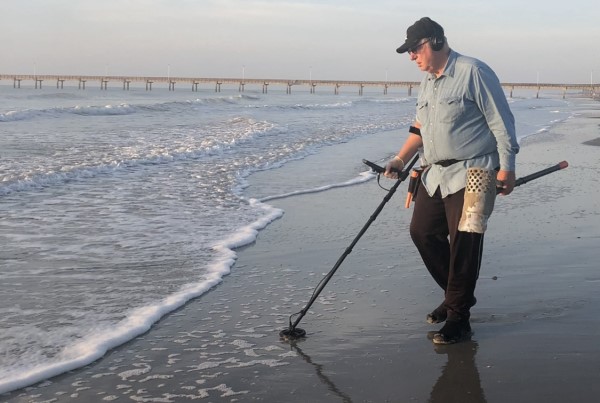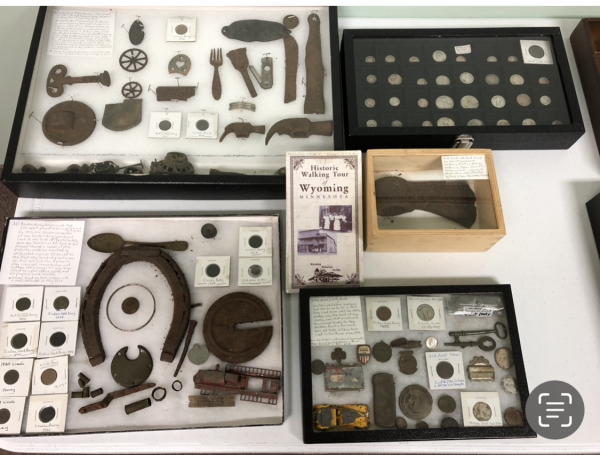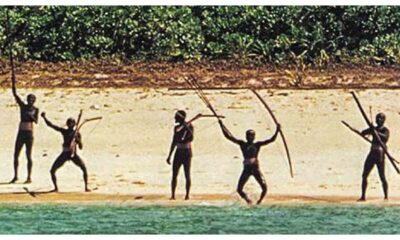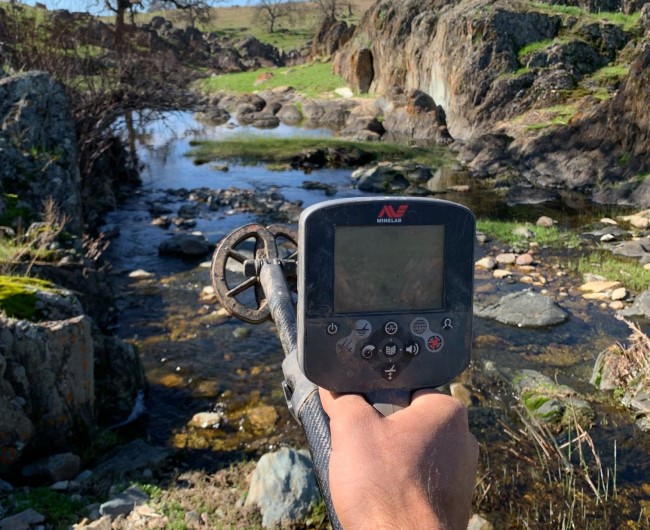Sports
Outdoor Fun & Profit: Be a Lord of Rings

Mark Gibson was once again out on a south Texas beach a couple hours before sunrise searching for lost treasure. He slowly walked the sand, swinging his Minelab EQUINOX 800 from side to side. After hunting many different beaches in his area since early October of last year, his signals were becoming few and far between. But it had been a profitable winter…
The tone coming from his 800 alerted him to another good sounding target. He slipped the blade of his scoop into the sand, pushed it down, and raised another scoop of Texas beach. He checked his hole and didn’t receive a signal. He knew the prize was in the scoop. After shaking the sand out through the holes, Gibson peered through the early morning light and saw ring number 88 for the winter in the bottom of his scoop.
When asked how he began his metal detecting hobby, Gibson replied, “I bought my first detector in 2010 and was hooked from day one. I found 400 quarters my first summer on our local beach in Minnesota. Winter stopped that for months at a time. I gradually moved up to better detectors, paying for them with my finds.”
In 2012, at age 57, he was offered early retirement, and everything changed. A year later, his wife, Shari also retired. They decided to travel the country and enjoy life. They sold their house, paid cash for a Minnie Winnie, and headed for two months in Alaska. During the next two years, their travels took them to every state in the country except five in the far northeast. Mark used his metal detector everywhere he could, panned for gold, and found coins, jewelry, and relics along the way.

He stopped in Florida and hunted the Treasure Coast near Sebastian, and continued along the southern coast to Texas, where they began spending the winters. During the summers, they returned to their hometown of Wyoming, Minnesota. Around 2015, he began his beach hunting in earnest in south Texas at an undisclosed location.
After several years of travel around the country, detecting every chance he had, Gibson had only found a handful of rings, however. He didn’t understand while during hundreds of hours of detecting, he hadn’t found more. When queried about his lack of success, he shared, “I met a guy on the beach who was using a Minelab CTX 3030 and we started hunting together. He was kicking my butt every time out, finding lots more than me. We buried some rings, and my detector was not even getting signals at the depths he was finding targets with his CTX.”
His first winter in Texas, he had found seven rings with his old detector. He purchased the Minelab CTX 3030 and finished the rest of the winter with 25 rings. As he got to know his new machine better, the next winter he added 52 rings, and the following year another 53 rings, plus lots of other jewelry and buckets of modern coins. He cashed in hundreds of dollars of clad in his first seasons.
Weather permitting, Gibson spends eight to twelve hours most days detecting his beach. While he loved his CTX, it was becoming too heavy for all those hours, especially with the 17-inch coil he was using. So, he switched machines again. He went with the Minelab EQUINOX 800. This was a great choice. The EQUINOX series (and the VANQUISH series) came out with Simultaneous Multi-Frequency Technology. For the first time, thanks to this Multi-IQ Technology, users could find any metal in any soil at any time. But Minelab was not satisfied. Just a few months ago, they released their newest generation Simultaneous Multi-Frequency engine: Multi-IQ+. This new feature transmits more power through the coil at an even wider range of operating frequencies. This allows better and more accurate detection of even more targets in the ground. Multi-IQ+ is standard on the new Minelab MANTICORE.
His first winter with his new EQUINOX 800, Gibson found his personal best, 100 rings. This was just after hurricane Harvey hit, stirring up the sand and exposing many targets. The following winter he found 97 more rings. When asked what his favorite type of detecting is, he responded, “Although beach hunting is my favorite, I still love detecting on land, especially old homesteads, schoolyards, parks, old yards, and other old or historic properties. I have detected most of the properties in my old hometown of Wyoming, Minnesota. I have filled three display cases of coins and relics from this area. I know most of the people in town, so getting permission to hunt is easy.”
After traveling most of the country for the last decade, and detecting along the way, Gibson has managed to find a lot of great items. Besides his hundreds of rings, he was able to share some of his best finds with the author. “My favorite coin find is an 1848 large cent found in my hometown of Wyoming, Minnesota. It was more than likely dropped by one of the original settlers that came to that area from Pennsylvania around 1850. That was my oldest coin to date until I dug a British King George III copper penny in the historic town of Pembina, ND. This was minted between the mid-1700’s and 1820. The museum in town helped me identify it.”
Of course, with all his ring finds, a few of those are also special. He has found a silver ring with 10 carats of natural pink rubies, a white gold 18K men’s ring with eight large diamonds, and a recent platinum ring with almost a full carat diamond in the middle with smaller diamonds on the sides. His favorite relic is an old token which says “Good for 2 &1/2 cents in trade” at the Avenue pool room.
Gibson was asked if he ever attended “seeded” hunts. He replied with, “I’ve only been to two seeded hunts, and they were both in Iowa. They were sponsored by my favorite detecting group on Facebook, Detecting the Heartland.”
One of Gibson’s favorite parts of the hobby are ring returns. He found a college class ring on the beach in Texas. The lady was in the military and had lost the ring while on spring break. Gibson and his wife, Shari, were able to track her down from the information on the ring. She had been reassigned to somewhere in Italy and he was able to return her ring to her there. Another great return was a multi-generational diamond ring which went back four generations. The lady had just found out her cancer which had been in remission had returned. She had lost the ring while working in the garden. Her husband contacted Gibson and asked if he could look for it. She showed him where she thought she lost it. Five minutes later, his Minelab EQUINOX 800 gave a solid mid-tone signal. He parted the grass and the ring was there.
Gibson also shared this thought. “I am in better shape now, both physically and mentally than ever before and I attribute a lot of that to this hobby. It’s hard to describe being out under the Texas sky with a million stars overhead with just my headlamp and detector and two hours later watching a brilliant sunrise and the beach and the birds and the animals come to life. It’s a slice of heaven on earth.”
–Guest post courtesy Rich Creason
-

 Hunting2 weeks ago
Hunting2 weeks agoHow to Score Deer Antlers: Boone & Crockett Guide
-

 Accessories2 months ago
Accessories2 months agoKilian Jornet States of Elevation Midway Update
-

 Uncategorized1 month ago
Uncategorized1 month agoBest Corn Mazes 2025: Top 10 in the US for Fall Fun
-

 Primitive Survival5 hours ago
Primitive Survival5 hours agoJohn Allen Chau: North Sentinel Island Tragedy – 7th Anniversary

